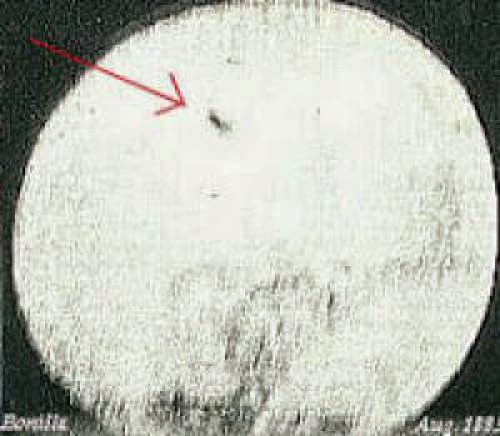
By Doug Burrow
The Watcher Report1883: The First UFO Photo
There is a first for everything, and UFO photos are no exception. The year was 1883, just a few years before the first UFO flap, the Great Airship Mystery (1) of 1897, but with some reports dating back to the 1880s. The photographer, Jose Bonilla, was an astronomer working out of the Zacatecas Observatory in Mexico. On August 12, 1883, Bonilla was observing the Sun and drawing sun spots when:
I suddenly saw a small light entering the field of the lens, seen on the paper that I used to reproduce sunspots, and, crossing the solar-disc, it then looked like a shadow almost circular.
I had not recovered from my amazement when the same phenomenon was reproduced again, and then again, so often that in a space of two hours I could count up to 283 bodies across the solar disk. (2)
After the initial sighting cloudes interferred, and it was about 40 minutes before he could directly observe the Sun again. Then:
During that period I counted 48 other bodies again. The paths followed by these bodies indicate a direct shift from west to east, more or less inclined to the north or south of the solar disc. During this short observation I noticed that those bodies that appeared dark-black and perfectly round and some other more or less elongated when seen against the solar disc, became bright images as they left its edges and moved across the outer field of the lens.
Their time intervals were variable, a body passing through would not take more than one third, half a second, or at most one second to cross the disc, and a minute or two passed before others appeared - some passed as 15 or 20 at once, so that was difficult to count them. I drew the trajectory of many of these bodies on the solar disc, marking their `entrances' and `exits' on the paper that I used to draw sunspots; as the lens of the equatorial moved, through a system of clockwork gears, following the apparent movement of the Sun on the celestial sphere.
...Taking photographs of the Sun frequently, when its image shows sunspots and remarkable facula, I was already in a position to photograph this equally rare and interesting phenomenon: the passage of these bodies across the solar disc. (3)
These sightings continued for a period of 36 hours, witnessed not only by Bonilla, but also his assistant. Bonilla reported that, "The photograph was taken at Collodion process to 1 / 100 second. This speed gave me no time to properly prepare the filter and (chemical)baths but also the negative is somewhat veiled by the developer. The image of the Sun is not in focus, but that of the bodies, to which I gave at that time greatest interest."
Not only was Jose Bonilla the first to photograph a UFO, but it is fortunate that it was an astronomer who took it. His observations and methods are meticulous, and he was more than qualified to not only describe objectively what he was seeing, but had the scientific tools to give us details that would have been lacking but ordinary, untrained, witnesses. For example, he estimated that the objects were 242,000 Km out, or about 2/3s of the distance to the moon.
Bonilla described the shape of the objects as, "perfectly round and some other more or less elongated." This matched the classical saucer or disk-shape later reported by Kenneth Arnold (4), but it is the elongated shape which intrigues me as the Great Airship flap, which occurred shortly after Bonilla's sighting, featured cigar-shaped or elongated craft. It is my belief that what the people of the time my have been witnessing was not unlike current reports of triangular-shaped craft, i.e., these were early experimental craft not of extraterrestrial origin, but a secret project very much based on human technologies. However, these "airships" obviously could not have had outer space capacity as these sightings by Bonilla clearly had. So perhaps Bonilla's sightings were unrelated to The Great Airship Mystery...? Sort of puts the "U" back into UFO.
Bonill'a photographs and investigation provide a historical marker and a pattern for scientific investigation that continues to our own day, but one thing has not changed: this phenomenon remains as unexplained today as it did then, and now, as then, I believe that no one theory suffices to explain the mystery.
NOTES:
1. Mystery Airship, Wikipedia.
2. Jose Bonilla reported his observations to the French Journal, "L'Astronomie."
3. Translation from the original Spanish by Perceptions.
4. Kenneth Arnold, Wikipedia.
RELATED ARTICLES:
* Perceptions
* TinWiki, Above Top Secret
THE WATCHER REPORT
"FIGHT THE FUTURE! JOIN THE RESISTANCE @ FACEBOOK/WATCHERREPORT!"FIGHT THE FUTURE! JOIN THE RESISTANCE @ FACEBOOK/WATCHERREPORT!"











0 comments:
Post a Comment